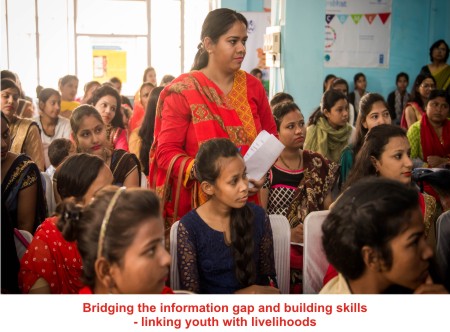|
Employment and
Apprenticeship: There are 1.2 billion people in the world below the poverty line and they survive on less than $1 a day, out of which roughly a third of them live in India. Their economic development would definitely increase their quality of life. Thus, in recent times, there has been a lot of importance given to livelihoods and skill development, especially for unemployed youth.
While many
institutions and government agencies are focusing on skill development
and related placements, very few of them are covering the entire
spectrum especially the apprenticeship and post-placement journey. When
trainees are placed at entry-level jobs, their need for on-the-job
training and post-placement counselling and access to information
regarding their further training and job mobility is extremely high.
Lack of this ecosystem is a major reason for high attrition rates and
drop-outs post placements. The overall ‘first job’ experience for almost all the trainees is extremely overwhelming as they face several kinds of emotional and social challenges and struggle to cope with them. The trainees also struggle to enhance their skills post placements as they do not have readily available access to refresher courses and short-term training programmes. Once they have joined jobs, it is an economic loss for them to enroll into refresher or up skilling courses as they would have to take leaves from their jobs. As a result, their knowledge growth is extremely slow paced. This further leads to very slow upward movement for them in their jobs. The contribution of girls and women in the workforce in India continues to remain low. There are 1400 training partners of NSDC, which are running more than 28,179 centres across India imparting skill/vocational training. A lot of emphasis has been given to skilling, but apprenticeships, placements and post training needs are not very strongly catered to. Trained candidates either do not get suitable employment or apprenticeship opportunity or discontinue the job as they either fail to understand the needs of the work environment or do not get the desired guidance, considering lack of post placement assistance opportunities. On the other hand, several employers face a very high attrition rate and have low or no access to trained pool of trainees. This problem is more acute for service sector companies, as attrition rate continues to be over 30 percent monthly for all entry and mid-level jobs. There still exists a huge gap between the demand and the supply side of employment/self-employment/apprenticeship for most sectors, especially the service sectors in India. Currently as per recent government’s mandate to skill 400 million youth, there has been a lot of thrust on skill development initiatives in India. However, the focus for girls and women remains a challenge. Majority of the girls and women do not enter the workforce and this leads them to not being able to reap economic benefits. While a lot of efforts are now going towards training them through several kinds of centres, job placements and employment still remains a huge challenge. Employers often share their observations that the quality of trainees is not up to mark for both apprenticeship as well as employment, and hence they face a lot of issues during the interview to on boarding processes. Most employers are not even aware of several government schemes such as National Apprenticeship Promotion Scheme (NAPS) etc. Apprenticeship training is one of the most efficient ways to develop skilled manpower for industry by using training facilities available in the establishments without putting any extra burden on exchequer to set up training infrastructure. Individuals after undergoing apprenticeship training can easily adapt to the industrial environment at the time of regular employment. The other advantages of apprenticeship training are as follows:
NSDC has
recently started anchoring Apprentic Through this coalition, several solutions shall be developed and deployed such as but not limited to:
At the end of the project, all insights gathered shall be shared with all relevant stakeholders for cross learning and knowledge sharing. We are now working on deploying this unique apprenticeship-employment coalition model and look forward to like-minded professionals and institutions to connect with us to improve the outcome from this endeavour. ■
Manisha Mishra
|

 eship including the National
Promotion Scheme (NAPS) in India and has also developed the beta version
of the NAPS portal to ease out the process of matching supply and demand
of trainees (Apprentices), Training Partner Agencies (TPA) and Employers
(Establishments). The policy proposes to pro-actively work with industry
including MSME sector to facilitate a tenfold increase in apprenticeship
opportunities in the country by 2020.
eship including the National
Promotion Scheme (NAPS) in India and has also developed the beta version
of the NAPS portal to ease out the process of matching supply and demand
of trainees (Apprentices), Training Partner Agencies (TPA) and Employers
(Establishments). The policy proposes to pro-actively work with industry
including MSME sector to facilitate a tenfold increase in apprenticeship
opportunities in the country by 2020.